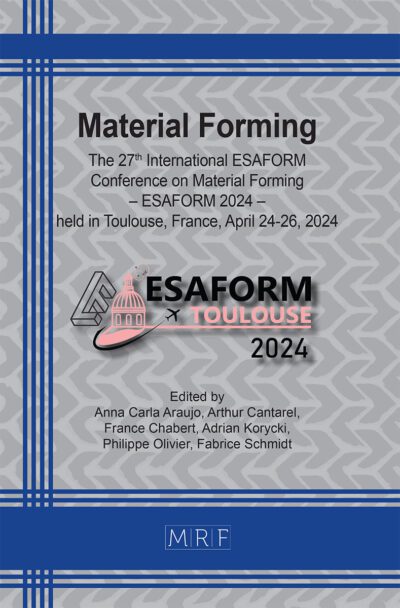Hole expansion limit prediction for DP980 steel sheet
Kazuma Kita, Toshihiko Kuwabara, Tomoki Nedachi, Yuya Murai, Nobuyuki Seki
Abstract. This study proposes a practical method for predicting the timing and location of localized necking in stretch flange forming. First, uniaxial tensile tests were performed for every 15° from the rolling direction of the test material, DP980 steel sheet. Then, Fracture Limit Strain (FrLS) is determined as the strain at the onset of localized necking for each tensile direction. Next, hole expansion tests (HET) were performed for the test sample. It was experimentally conformed that the timing and location of the fracture in the HET was almost consistent with those at which the maximum principal strain, ε_1, in the vicinity of the hole edge reached the FrLS for that direction.
Keywords
Hole Expansion, Experiment, Fracture Strain, Uniaxial Tension, Anisotropy
Published online 5/7/2025, 7 pages
Copyright © 2025 by the author(s)
Published under license by Materials Research Forum LLC., Millersville PA, USA
Citation: Kazuma Kita, Toshihiko Kuwabara, Tomoki Nedachi, Yuya Murai, Nobuyuki Seki, Hole expansion limit prediction for DP980 steel sheet, Materials Research Proceedings, Vol. 54, pp 1020-1026, 2025
DOI: https://doi.org/10.21741/9781644903599-110
The article was published as article 110 of the book Material Forming
![]() Content from this work may be used under the terms of the Creative Commons Attribution 3.0 license. Any further distribution of this work must maintain attribution to the author(s) and the title of the work, journal citation and DOI.
Content from this work may be used under the terms of the Creative Commons Attribution 3.0 license. Any further distribution of this work must maintain attribution to the author(s) and the title of the work, journal citation and DOI.
References
[1] M. Feistle, R. Golle, W. Volk, Edge crack test methods for AHSS steel grades: A review and comparisons, J. Mater. Processing Technol. 302 (2022) 117488. https://doi.org/10.1016/j.jmatprotec.2021.117488
[2] E. Iizuka, M. Urabe, Y. Yamasaki, T. Inazumi: Effect of strain gradient on stretch flange deformation limit of steel sheets. J. JSTP, 51-594 (2010) 700–705. (in Japanese) https://doi.org/10.9773/sosei.51.700
[3] H. Takuda, K. Ozawa, T. Hama, R. Yoshida, J. Nitta, Forming Limit Prediction in Bore Expansion by Combination of Finite Element Simulation and Ductile Fracture Criterion, Mater. Trans. 50 (2009) 1930-1934. https://doi.org/10.2320/matertrans.P-M2009817 M. G. Cockcroft, D. J. Latham, Ductility and the Workability of Metals, J. Inst. Metals 96 (1968) 33–39.
[4] J. Ha, S. Coppieters, Y.P. Korkolis, On the expansion of a circular hole in an orthotropic elastoplastic thin sheet, Int. J. Mech. Sci. 182 (2020) 105706. https://doi.org/10.1016/j.ijmecsci.2020.105706
[5] F. Barlat, J.C. Brem, J.W. Yoon, K. Chung, R.E. Dick, D.J. Lege, F. Pourboghrat, S.-H. Choi, E. Chu, Plane stress yield function for aluminum alloy sheets —part 1: theory, Int. J. Plast. 19 (2003) 1297–319. https://doi.org/10.1016/S0749-6419(02)00019-0
[6] V.K. Barnwal, S.Y. Lee, S.Y. Yoon, J.H. Kim, F. Barlat, Fracture characteristics of advanced high strength steels during hole expansion test, Int. J. Fract., 224 (2020) 217-233. https://doi.org/10.1007/s10704-020-00458-y
[7] J.R. Rice, D.M. Tracey, On the ductile enlargement of voids in triaxial stress fields, J Mech Phys Solids 17 (1969) 201–217. https://doi.org/10.1016/0022-5096(69)90033-7
[8] H.-S. Park, F. Barlat, S.-Y. Lee, Comparison of anisotropic yield functions and calibrations for accurate thickness prediction in hole expansion test, J. Mater. Processing Technol. 319 (2023) 118070. https://doi.org/10.1016/j.jmatprotec.2023.118070
[9] Y. Iizuka, T. Kuwabara, H. Hayamizu: Hole expansion limit for 6000-series aluminum alloy sheet. J. JILM, 72 (2022) 702–707. (in Japanese) https://doi.org/10.2464/jilm.72.702
[10] T. Kuwabara, F. Barlat, Deformation Behavior of Aluminum Alloys under Various Stress States: Material Modeling and Testing, Mater. Trans. 65 (2024) 1193-1217. https://doi.org/10.2320/matertrans.MT-L2024010












